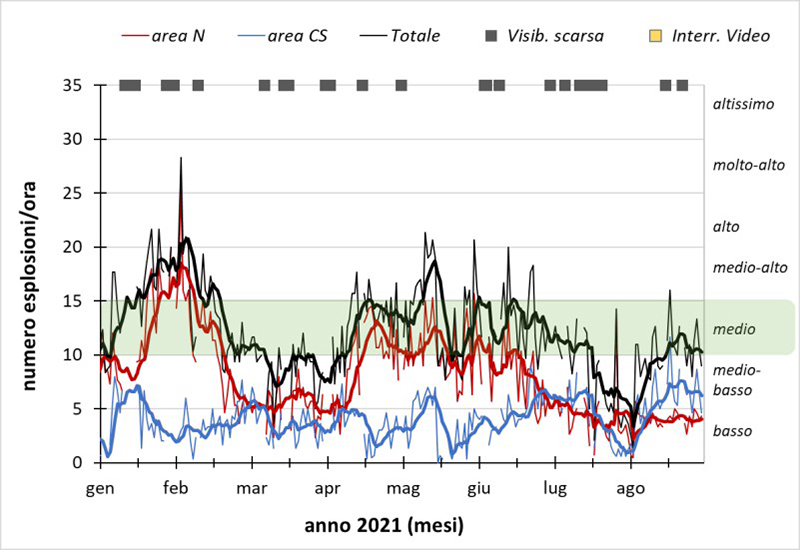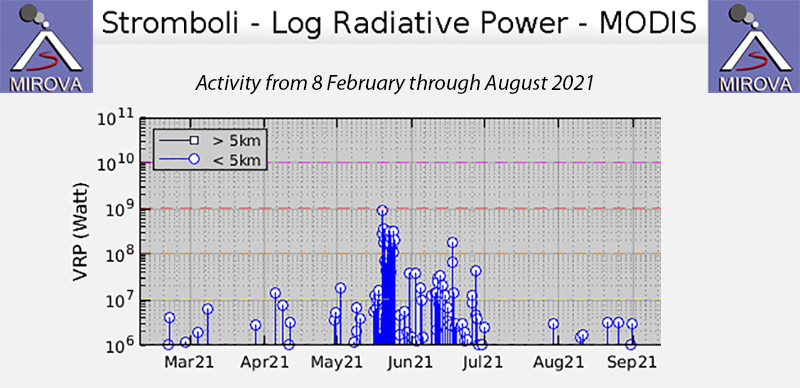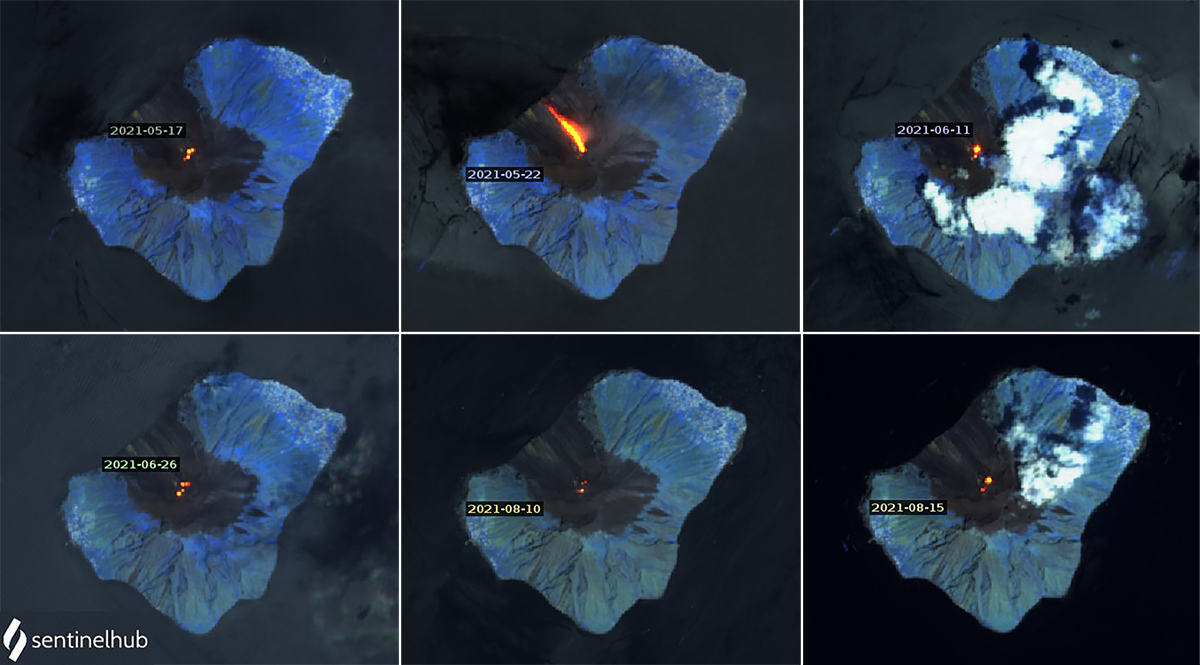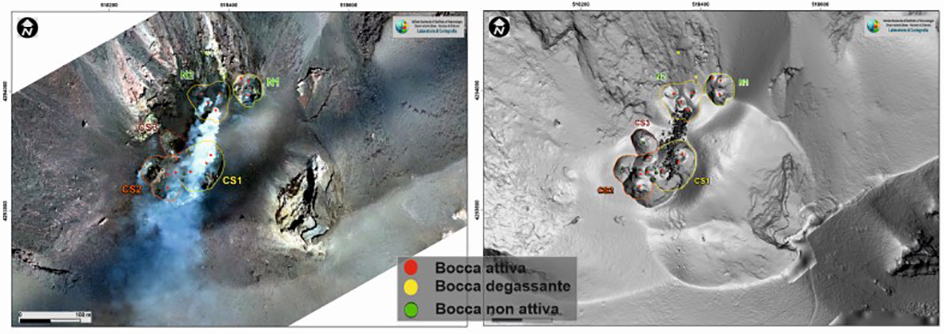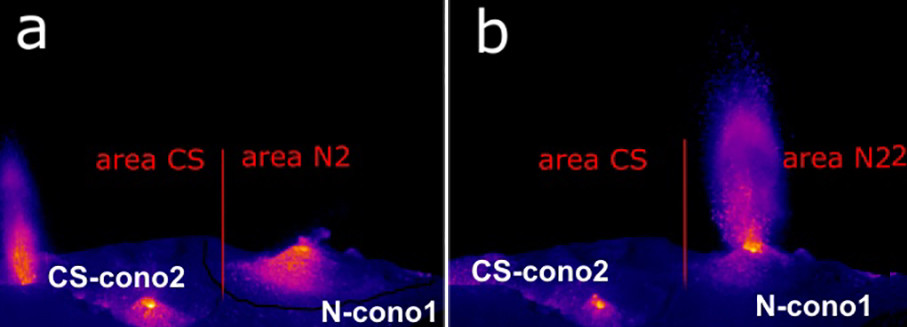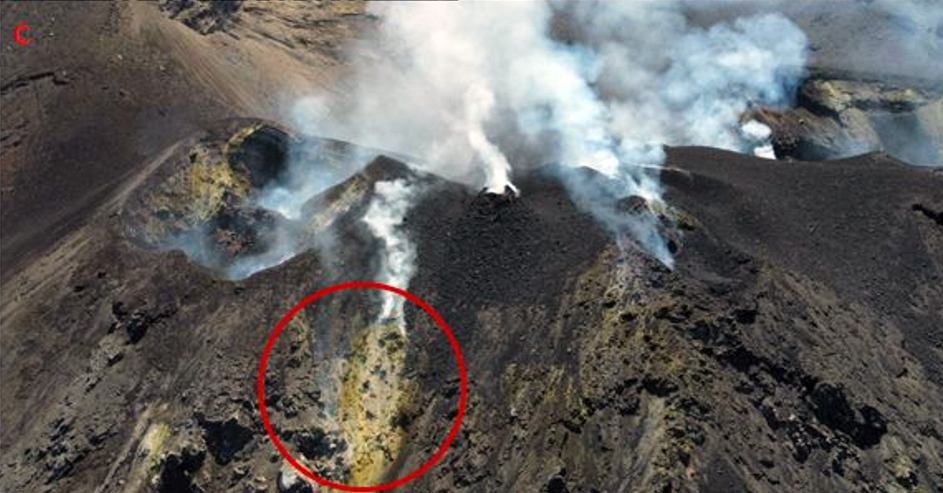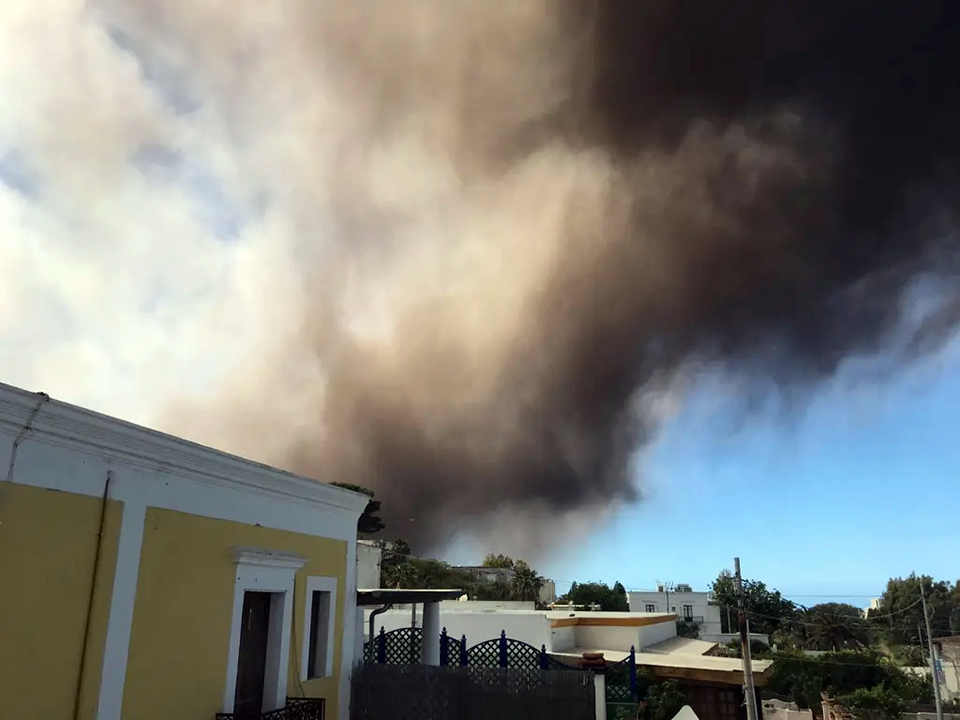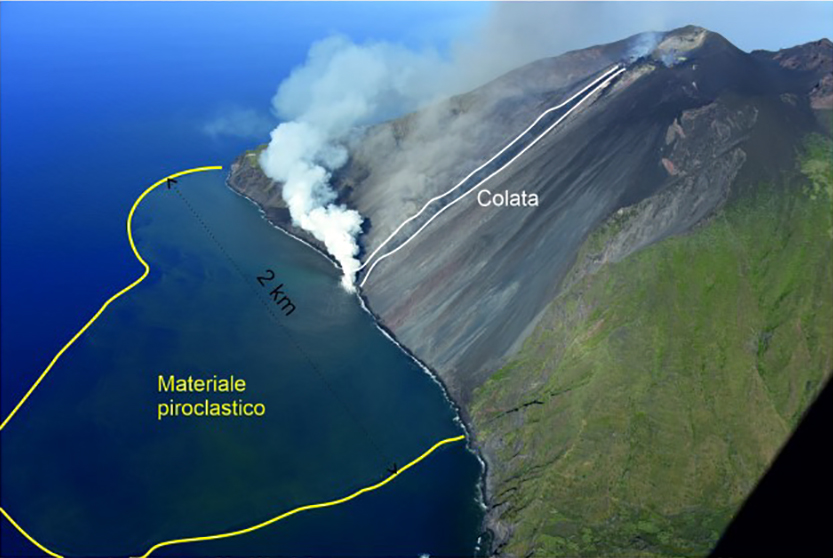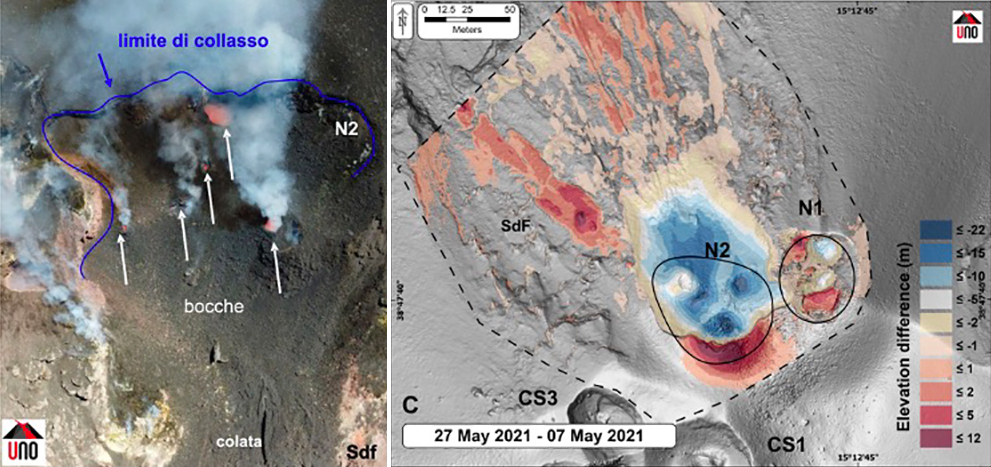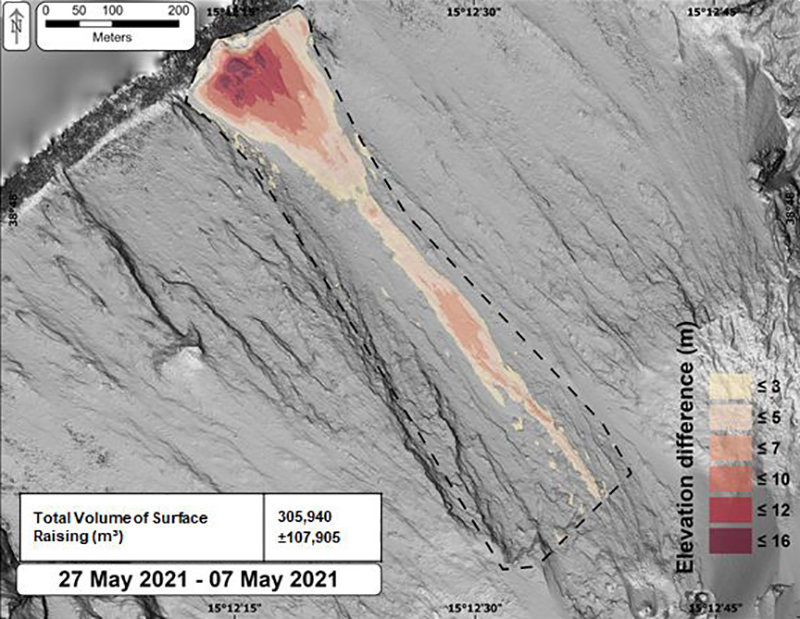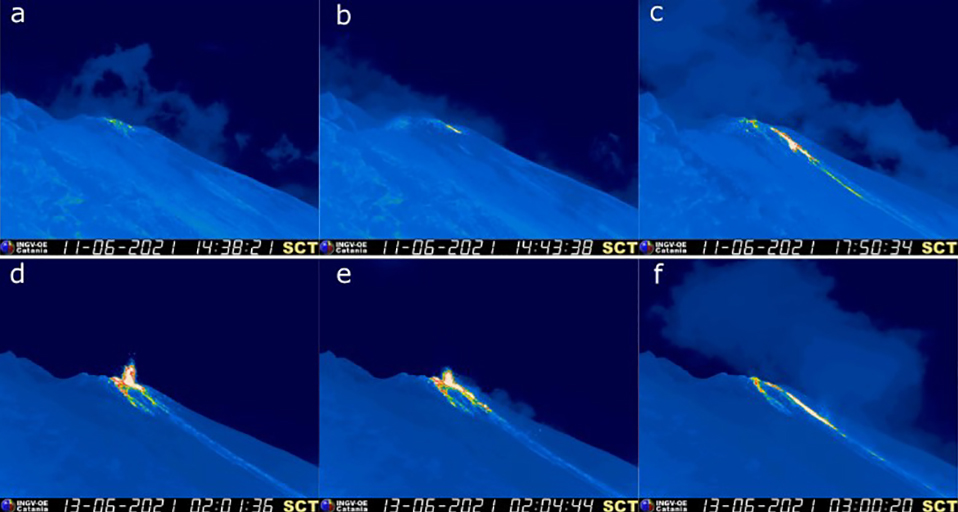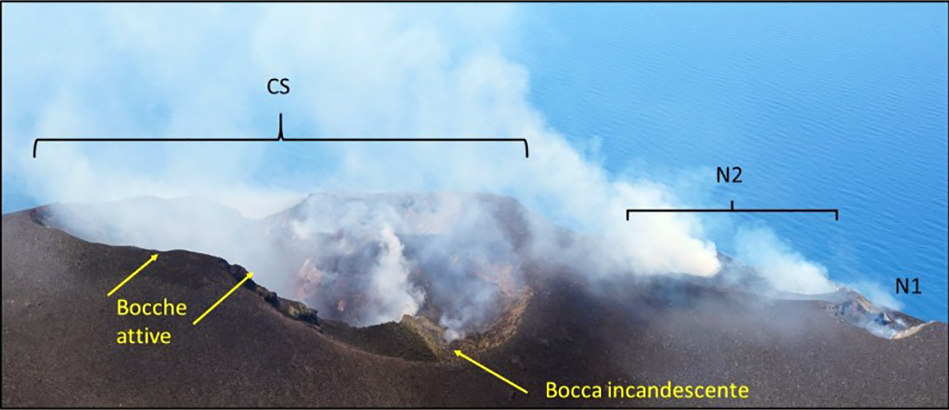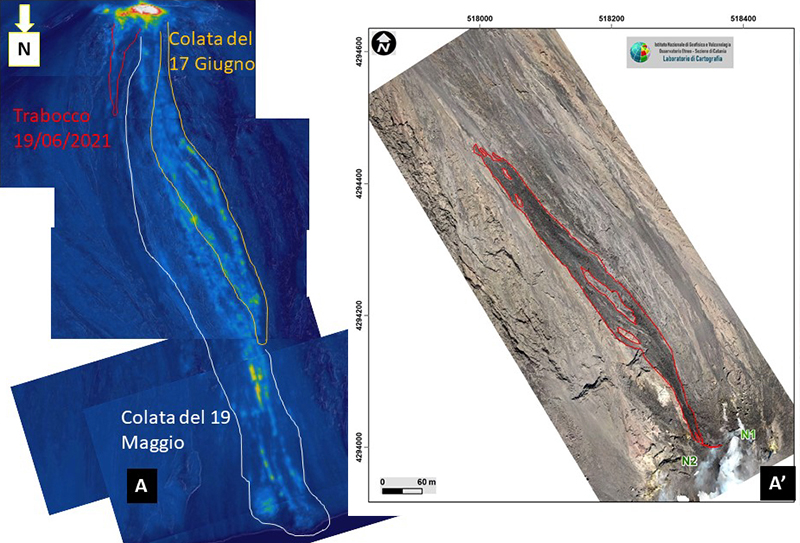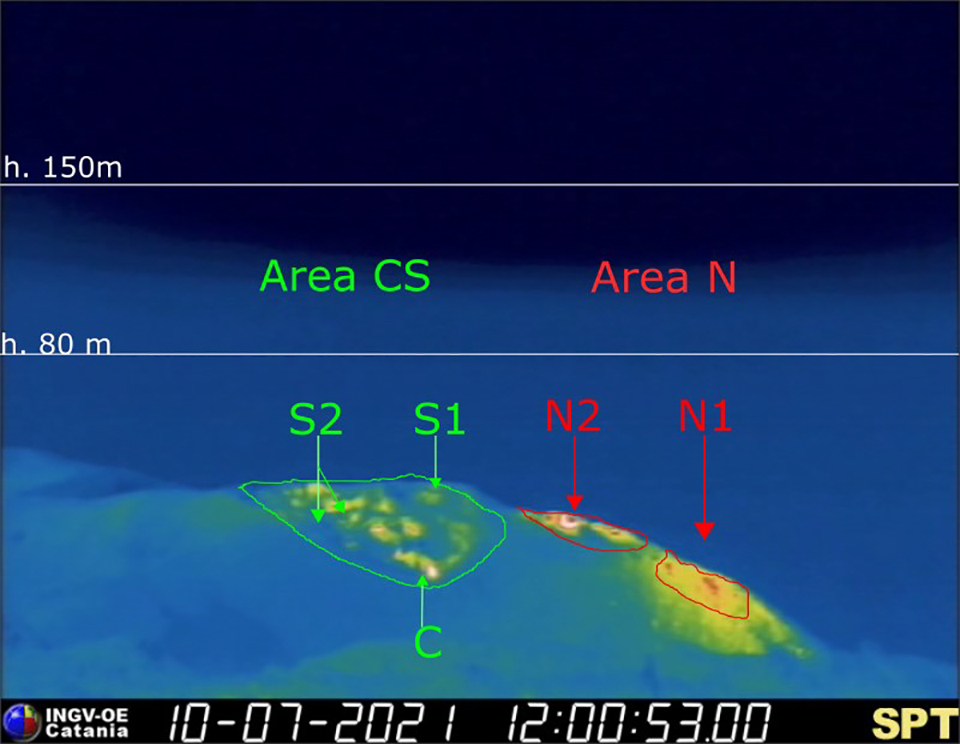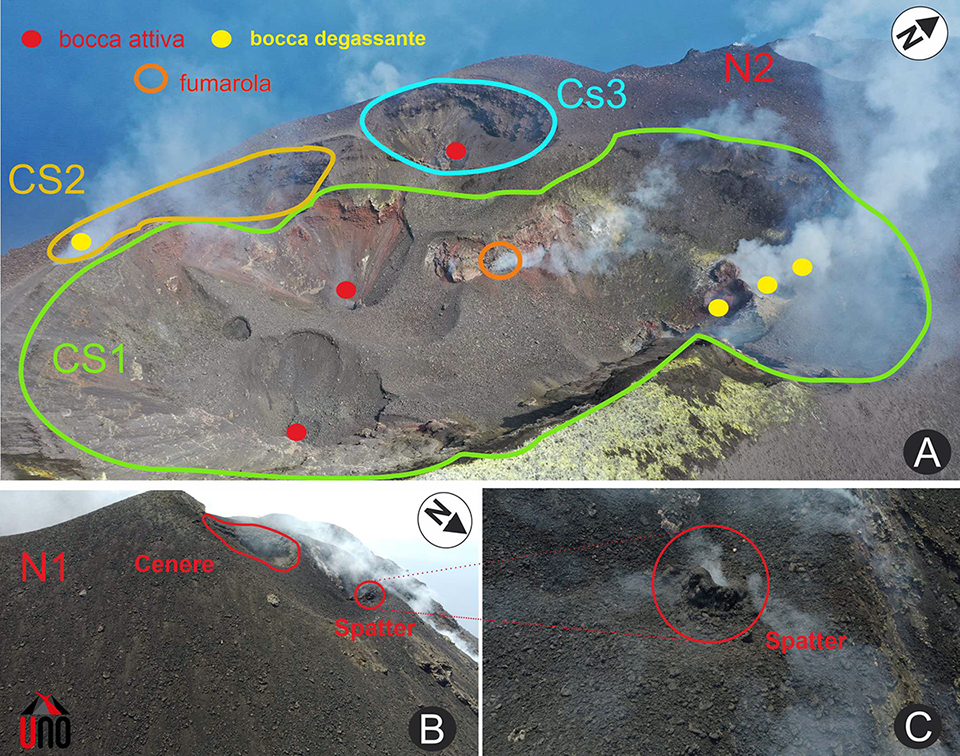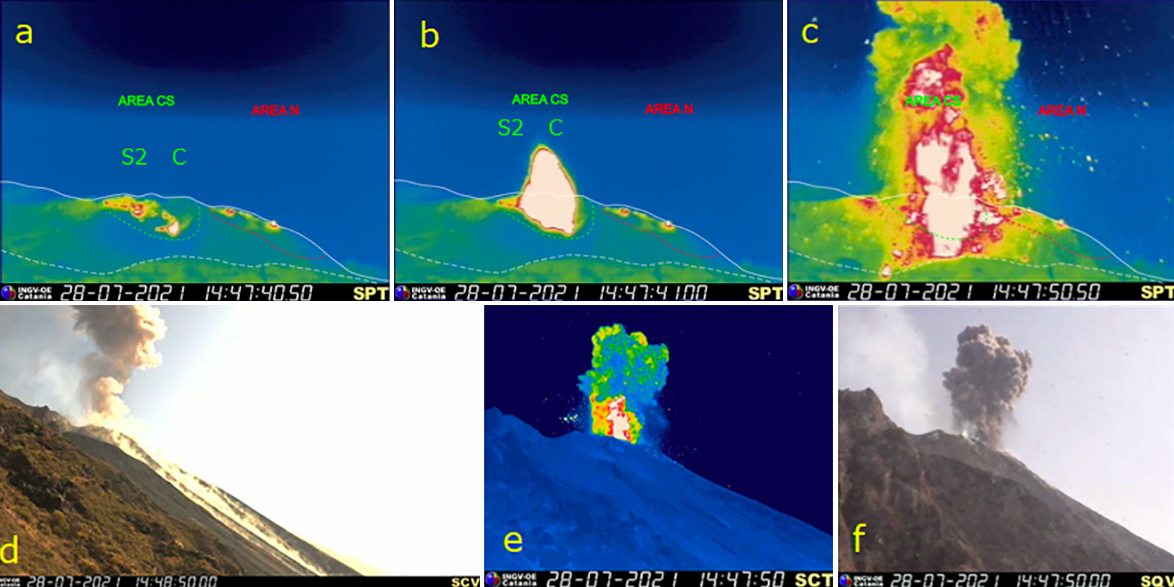Report on Stromboli (Italy) — October 2021
Bulletin of the Global Volcanism Network, vol. 46, no. 10 (October 2021)
Managing Editor: Edward Venzke.
Edited by A. Elizabeth Crafford.
Stromboli (Italy) Pyroclastic flow extends 1 km into the sea on 19 May 2021
Please cite this report as:
Global Volcanism Program, 2021. Report on Stromboli (Italy) (Crafford, A.E., and Venzke, E., eds.). Bulletin of the Global Volcanism Network, 46:10. Smithsonian Institution. https://doi.org/10.5479/si.GVP.BGVN202110-211040
Stromboli
Italy
38.789°N, 15.213°E; summit elev. 924 m
All times are local (unless otherwise noted)
Nearly constant fountains of lava at Italy’s Stromboli have served as a defining character of this SE Tyrrhenian Sea volcano for at least 2,000 years. Eruptive activity at the summit consistently occurs from multiple vents at both a north crater area (N area) and a central-southern crater area (CS area) on a cratered terrace known as the ‘terrazza craterica’ at the head of the Sciara del Fuoco, a large scarp that runs from the summit down the NW side of the volcano-island. Periodic lava flows emerge from the vents and flow down the scarp, sometimes reaching the sea; occasional large explosions produce ash plumes and pyroclastic flows. Thermal and visual cameras that monitor activity at the vents are on the nearby Pizzo Sopra La Fossa, above the terrazza craterica, and at multiple flank locations. Detailed information for Stromboli is provided by Italy's Istituto Nazionale di Geofisica e Vulcanologia (INGV) as well as several satellite sources of data; May-August 2021 is covered in this report.
Summary of activity during May-August 2021. Stromboli maintained typical levels of explosive activity throughout most of May-August 2021 with the exception of a significant pyroclastic explosion on 19 May, and short periods of increased activity in late June and late July (figure 204, table 12). The thermal activity for the period was high during late May and June, but low during the rest of the period according to the MIROVA graph of radiative power (figure 205). Sentinel-2 satellite imagery also showed fluctuations in the number of active vents and in the amount of thermal intensity at the vents throughout the period, with a strong thermal anomaly from the 19 May pyroclastic flow (figure 206).
Table 12. Summary of type, frequency, and intensity of explosive activity at Stromboli by month. Courtesy of INGV weekly reports.
| Month | Explosive Activity | Additional Activity |
| May 2021 | Typical Strombolian activity, with occasional episodes of intense spattering at vent N2. The frequency of explosions was 8-21/hour, with low to medium-high intensity in the N area and medium-high intensity in the CS area. Explosion on 19 May produced pyroclastic flow. | Radial deformation observed 2-4 May, seismic tremor amplitude increased on 11 and 24-25 May. Pyroclastic flow 19 May, lava flows 19-20 May |
| Jun 2021 | Typical Strombolian explosive activity, occasionally accompanied by intense spattering at vent N2. The frequency of explosions was medium-low to medium-high with 9-16 events/hour except on 4 June with 21 events/hour (high level). The intensity of the explosions were low to medium in the N area and medium to high in the CS area. | Tremor amplitude increased 1-2 and 11 June. Landslide on 16 June. Lava overflows on 17, 19, 21, 23, and 25 June. |
| Jul 2021 | Typical Strombolian explosive activity, accompanied by occasional intense spattering activity at vent N2. Low to medium-high frequency of events in the range of 2-18 events/hour decreased towards the end of the month. The intensity of the explosions varied from low to high in both the N area and the CS area. | Medium-high energy explosions on 14 and 28 July. |
| Aug 2021 | Typical Strombolian explosive activity. Hourly explosion frequency ranged from low to medium with 1-13 events/hour, except for 16 events/hour on 23 August. Explosion intensity was low to medium-low in the N area throughout the month and increased briefly from low to medium-high at the CS area during the middle of the month. | Large explosion on 1 August. |
Activity during May 2021. During a visit on 26 April 2021 INGV scientists noted that the N area had three emission sites that included one hornito producing a mixture of ash, lapilli, and bombs; the CS area had one hornito and a deep crater area producing lapilli and bombs (figure 207). A Digital Surface Model (DSM) of the crater area compiled from data on 8 May compared with the 31 March model (figure 208) revealed that the N1 crater had widened by 8 m in the SW direction and had three active vents. Inside the N2 crater, two scoria cones with a diameter of about 20 m each had formed and two others had coalesced to form a 25 m wide feature where previously there had been crater depressions. There were four active vents. Craters CS 1 and 2 were coalescing and contained ten vents, seven of which were active. The southwestern edge had widened by a few meters towards the SW. The CS 3 crater was unchanged with one inactive vent.
During field observations over 10-16 May 2021, INGV scientists noted that intense spattering had built a large cone in the N2 crater area, and frequent explosions in the CS area were interrupted by intense spattering from the two vents of the cone in that area (figure 209). The vent in the S part of the CS area also produced explosions of coarse tephra that, at times, exceeded 200 m in height. Intense degassing was first noted on the flank of the N area beginning on 11 May with weak and discontinuous explosive activity observed by field personnel on 14 May (figure 210).
On 19 May at 1251 UTC, after an episode of intense spattering activity from the N2 crater in the N area, the edge of the N2 crater overlooking the Sciara del Fuoco collapsed. The collapse caused the formation of a pyroclastic flow which reached the coastline at a speed of about 50 m/s and traveled more than 1 km across the ocean surface. The Toulouse VAAC reported a narrow ash plume that rose to about 2 km altitude and drifted E (figure 211). Trace amounts of ashfall were recorded in San Vincenzo on the E flank. Additional pyroclastic flows of lesser intensity continued for about 30 minutes. A lava flow began from the collapse site about 20 minutes after the explosion and flowed down the Sciara to the coast (figure 212). Webcams indicated that on 20 May the lava flow was still being fed.
The volume of pyroclastic material released as of 24 May 2021 was estimated at 450,000 ± 150,000 m3. Observations by INGV personnel on 26-27 May confirmed that the lava flow was no longer active, as suggested by satellite data two days earlier. Six vents were actively spattering at the N2 crater, with four of them aligned and erupting simultaneously (figure 213). They also noted that the pyroclastic cone that had occupied the center of the N2 crater until 16 May had been partially destroyed; no fresh ejecta was found on the Pizzo above the vents. Ash emissions and gas jets resumed at the N area without noticeable spattering on 27 May. A new DSM model with data from 27 May allowed comparison with the 7 May data to determine the volume and location of material involved in the 19 May event (figure 213); the collapse involved both the N2 crater area and the upper part of the Sciara del Fuoco near the N area. INGV determined that the minimum volume of material involved was likely around 70,000 m3, although they concluded that significant material had been added to the crater between 7 May and 19 May, indicating that the volume of material removed was likely greater. A similar analysis for the lava flow that was active on the Sciara del Fuoco between 19 and 24 May indicated that the volume of material added to the slope was around 300,000 m3 (± 100,000). Again, this value was considered an underestimate because it didn’t consider the material that flowed into the N2 crater or was deposited below sea level (figure 214).
Explosive activity was observed in the webcams throughout May 2021. The N Area included explosions from three vents at the N1 crater and four vents at the N2 crater, occurring at a rate of 8-15/hour of varying intensity from low to medium-high (sometimes the ejecta reached 250 m high); short intervals of intense spattering occurred during 27-30 April, 2, 6, 12, and 15 May. Ejecta was primarily lapilli and bombs, with some ash. Prior to the events of 19 May, the explosion frequency was around 12-15 events/hour, and dropped to 8-10 events/hour afterwards. The CS area had at least three vents with medium and high intensity explosions (over 250 m high) of coarse and fine ejecta. The explosion frequency of the CS Area was 5-7/hour before 19 May and dropped to low or nothing afterwards.
Activity during June-August 2021. Activity recorded in the webcams during June 2021 indicated that in the N area, crater N1 had two vents and produced explosions varying from low to medium intensity with the ejecta consisting of lapilli and bombs mixed with ash reaching 150 m high. The N2 crater, with four vents, showed variable explosive activity from low to medium-high (sometimes the ejecta reached 250 m) of mainly lapilli and bombs, with continuous spattering that intensified during 3-5, 7, 12, 13, 15, 17 and 20 June; intense spattering caused short lava overflows on 21, 23, and 25 June. The average frequency of the explosions fluctuated between 6 and 16 events/hour. In the CS area there were at least two vents with explosions of primarily ash, of medium and sometimes high intensity. The explosive activity showed average hourly frequency values ranging from less than 1 to 6 events/hour. During the last week of the month there were as many as eight active vents in the CS Area. Two were at the S side and produced medium-high intensity explosions up to about 200 m of primarily ash, and one was more in the center and produced discontinuous low-intensity explosions with more lapilli and bombs.
Two lava flows were recorded from the N2 crater on 11 and 13 June. The first flow on 11 June emerged from a vent on the S edge of the cone inside the N2 crater (figure 215) and traveled only a few tens of meters in the upper area of the Sciara before it stopped but then produced blocks that rolled down the slope for about eight hours. The second flow on 13 June began after an episode of intense spattering; the flow lasted about one hour and traveled a short distance down the upper part of the Sciara.
INGV carried out a site visit during 15-17 June 2021 at the summit and along the Sciara del Fuoco at an elevation of about 290 m. They observed on 15 June that explosive activity was concentrated in the N area, which included three active vents (figure 216). A single vent was active at the N1 crater producing episodic and medium intensity Strombolian explosions to 100 m, and there were alternating phases of strong spattering with ejecta exceeding 200 m, and intense degassing from two small cones at the head of the Sciara del Fuoco. Two main vents were active in the CS area; the southernmost was characterized by sporadic and intense ash explosions that included some lapilli and bombs rising to 200 m, and the more central vent had discontinuous low intensity explosions with more incandescent ejecta. A small vent with incandescence was active on the N side of the cone in the center of the terrazza craterica. A landslide on the Sciara del Fuoco during the afternoon of 16 June produced multiple blocks on the slope between 700 and 300 m elevation. This was followed on the evening of 17 June by the opening of a 30-m-long E-W fissure which produced a flow that descended the Sciara del Fuoco to 335 m elevation adjacent to the flow of 19 May (figure 217). A subsequent overflow on 19 June from the same fissure only traveled a few tens of meters before stopping. Additional small overflows were noted on 21, 23, and 25 June that remained at or above 700 m elevation on the Sciara del Fuoco.
Three vents were active in the N area during July 2021; crater N1 produced low to medium-high intensity explosions of lapilli and bombs sometimes mixed with ash (figure 218). Crater N2, with two vents, showed low intensity explosive activity (less than 80 m high) of lapilli and bombs with intense spattering at times. The average frequency of the explosions ranged between 1 and 10 events/hour. In the CS area, five vents were active; vent S1, on the cone overlooking the Sciara, produced low intensity explosions of ash, sometimes mixed with lapilli and bombs. Most explosive activity was observed at the S2 crater, with two vents that produced medium-high intensity explosions of lapilli, bombs, and ash where numerous explosions had ejecta that exceeded 150 m in height. A few low intensity explosions of lapilli and bombs occurred at crater C when it was not degassing. The explosive activity had average hourly frequency values ranging from 2 to 9 events/hour. The intensity of the activity decreased during the second half of July.
During 14 July, the terrazza craterica inside the CS area was impacted by a medium-high energy explosive sequence. The first explosion produced pyroclastic ejecta from both of the C vents. A few seconds later a smaller explosion from S1 was followed by two explosions of lapilli and bombs from the S2 crater. The explosions enlarged the crater around the C vents. Observations by INGV scientists on 23 and 25 July provided details of activity not observed in the webcams (figure 219). In the N area, the N1 crater had two active vents with simultaneous explosions of ash at the southern vent and spatter at the northern vent. The N2 crater had four active vents, including one with gas emissions and bombs and three with only degassing. In the CS area, and in particular at crater CS1, five active vents were observed, two of which produced abundant ash emission, sometimes simultaneously, and three were primarily degassing vents at the eastern edge. The active vent at CS2 was only degassing with no ejecta, and the active vent at CS3 had sporadic explosions and produced mostly reworked ash.
The typical eruptive activity of July was interrupted by a large explosion on 28 July 2021 followed by another on 1 August. The 28 July explosion occurred in the CS area near the C and S2 crater vents. The explosion reached about 200 m above the terrace; ejecta landed on the Pizzo and also sent blocks down the Sciara del Fuoco (figure 220). A second explosion on the night of 1 August also originated from the C vents of the CS Area and sent ejecta in all directions, including up to the Pizzo and down the Sciara del Fuoco. The explosion was followed by continuous and intense spattering activity for about two minutes from crater S2.
Eruptive activity during August was produced by three vents in the N area and six vents in the CS area. Crater N1 with two vents, produced medium-low intensity explosions of lapilli and bombs which caused the growth of hornitos and sent ejecta in all directions around the vents during the first half of the month. Later in the month, the activity was more low intensity explosions of ash with fewer lapilli and bombs. The N2 crater exhibited low intensity explosive activity with ash to less than 80 m high sometimes mixed with lapilli and bombs. The average frequency of the explosions fluctuated between 3 and 6 events/hour. In the CS area, vents at the S1 crater, located on the cone facing the Sciara, produced low intensity explosions of ash mixed with lapilli and bombs while the three vents at the S2 crater produced simultaneous explosions of low to medium-high intensity of ash mixed with lapilli and bombs. Crater C produced occasionally intense degassing. The frequency of the explosions fluctuated between 4 and 9 events/hour.
Geological Summary. Spectacular incandescent nighttime explosions at Stromboli have long attracted visitors to the "Lighthouse of the Mediterranean" in the NE Aeolian Islands. This volcano has lent its name to the frequent mild explosive activity that has characterized its eruptions throughout much of historical time. The small island is the emergent summit of a volcano that grew in two main eruptive cycles, the last of which formed the western portion of the island. The Neostromboli eruptive period took place between about 13,000 and 5,000 years ago. The active summit vents are located at the head of the Sciara del Fuoco, a prominent scarp that formed about 5,000 years ago due to a series of slope failures which extends to below sea level. The modern volcano has been constructed within this scarp, which funnels pyroclastic ejecta and lava flows to the NW. Essentially continuous mild Strombolian explosions, sometimes accompanied by lava flows, have been recorded for more than a millennium.
Information Contacts: Istituto Nazionale di Geofisica e Vulcanologia (INGV), Sezione di Catania, Piazza Roma 2, 95123 Catania, Italy, (URL: http://www.ct.ingv.it/en/; MIROVA (Middle InfraRed Observation of Volcanic Activity), a collaborative project between the Universities of Turin and Florence (Italy) supported by the Centre for Volcanic Risk of the Italian Civil Protection Department (URL: http://www.mirovaweb.it/); Sentinel Hub Playground (URL: https://www.sentinel-hub.com/explore/sentinel-playground); Toulouse Volcanic Ash Advisory Center (VAAC), Météo-France, 42 Avenue Gaspard Coriolis, F-31057 Toulouse cedex, France (URL: http://www.meteo.fr/aeroweb/info/vaac/).


